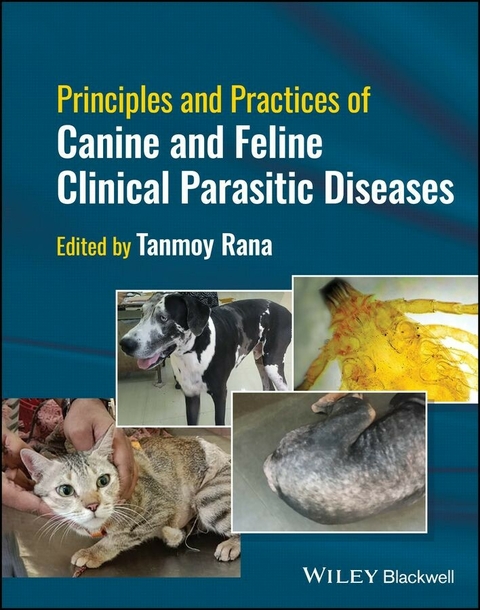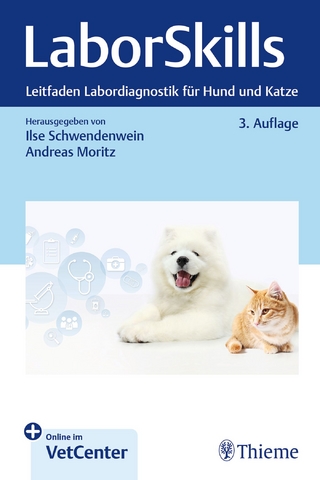
Principles and Practices of Canine and Feline Clinical Parasitic Diseases
Wiley-Blackwell (Verlag)
978-1-394-15824-9 (ISBN)
Parasitic diseases are a scourge for dogs and cats, and the impact of the numerous maladies associated with these diseases cannot be underestimated. For the clinician or researcher attempting to alleviate these symptoms, »Principles and Practices of Canine and Feline Clinical Parasitic Diseases« is a helpful, introductory practical guidebook that helps identify the parasites infecting these animals and suggests useful treatment strategies based on an appropriate diagnosis.
»Principles and Practices of Canine and Feline Clinical Parasitic Diseases« comprehensively details its topic from symbiosis and parasitism, to therapeutics measures and control strategies, to the deleterious effect of parasites in various organs in dogs and cats. The book offers extensive information on management approaches, the most significant clinical findings, diagnostic approaches, disease prevention, and drug evaluation. As a reference, the guide provides systems for the identification of the pathogens and recognizes the severity and exhibition of disease manifestation.
»Principles and Practices of Canine and Feline Clinical Parasitic Diseases« readers will also find:
- Preventative measures that can be utilized to prophylactically assure the continued health of the patient
- Chapters written by contributors with specialized knowledge in each particular subject presented
- The most up-to-date advanced research in the field of parasitic diseases
- Each chapter covers treatment schedules, details about the disease, and a management approach, using figures and line figures to aid in identification and treatment
»Principles and Practices of Canine and Feline Clinical Parasitic Diseases« is ideal for undergraduates, postgraduates, researchers, academics, and industrialists interested in the various parasitic diseases and treatments. It is also extremely useful as a ready reference for scientists seeking to develop new anti-parasitic drugs.
Tanmoy Rana, PhD, is an Assistant Professor in the Department of Veterinary Clinical Complex, West Bengal University of Animal & Fishery Sciences, Kolkata, West Bengal, India.
List of Contributors xxi
Preface xxv
Acknowledgment xxvii
1 General Introduction to Canine and Feline Parasitic Diseases 1
Sanweer Khatoon
1.1 Introduction 1
1.2 Type of Intestinal Parasites 5
1.3 Diagnosis, Treatment, and Prevention 6
1.4 Control 6
1.5 Internal Parasites 6
1.6 General Measures for the Prevention of Worm Infections 8
1.7 Anti- helminthics and Deworming Guidelines 9
2 Symbiosis and Parasitism in Dogs and Cats 11
Adedayo M. Awoniyi
2.1 Introduction 11
2.2 Examples of Dog and Cat Parasites 14
2.3 Recommendations and Conclusion 18
3 Risk Factors Associated with Parasitic Diseases in Dogs and Cats 19
Baleshwari Dixit, Rinesh Kumar, Alok K. Dixit, and Alok K. Singh
3.1 Introduction 19
3.2 Intrinsic Factors 21
3.3 External Factors 22
3.4 Control 28
4 Host–Parasite–Microbiome Interactions in Dogs and Cats 31
Furqan Munir, Amna Shakoor, Muhammad Tahir Aleem, and Zia ud Din Sindhu
4.1 Introduction 31
4.2 Microbiome of Parasites 32
4.3 The Microbiome of Dogs and Cats 32
4.4 Microbiomes and Helminths in the Guts of Dogs and Cats 33
4.5 Microbiota- mediated Protection 33
4.6 Why Do We Need to Study the Microbiota? 36
4.7 Future Perspectives 37
4.8 Conclusion 37
5 Linguatula serrata Worm Infections in Dogs and Cats 41
V. G. Charitha, C. Sreedevi, V. C. Rayulu, and P. M. Kondaiah
5.1 Introduction 41
5.2 Taxonomy 41
5.3 Historical Perspective 42
5.4 Incidence and Geographical Distribution 43
5.5 Morphology 43
5.6 Life Cycle 46
5.7 Pathogensis and Clinical Signs 46
5.8 Diagnosis 48
5.9 Treatment and Control 48
6 Annelida Infestations in Dogs and Cats 53
Hanumappa Dhanalakshmi
6.1 Leech Structure 53
6.2 Leech Organ Systems 53
6.3 Reproduction 53
6.4 Life Cycle 54
6.6 Feeding 55
6.7 Morphological Characteristics of Leech Families 55
6.8 Transmission 58
6.9 Pathogenesis 58
6.10 Treatment 58
6.11 Control 59
7 Insecta Infestations in Dogs and Cats 61
Anil Kumar, Tanmoy Rana, Sonam Bhatt, and Ankesh Kumar
7.1 Introduction 61
7.2 Diptera (Flies) 61
7.3 Phthiraptera (Lice) 64
7.4 Siphonaptera (Fleas) 65
7.5 Hemiptera (Bed Bugs) 67
7.6 Ticks and Mites 67
8 Acanthocephala Worm Infections in Dogs and Cats 73
Ramesh Putchakayala and Gurram S. Haritha
8.1 Origin and Classification 73
8.2 General Description 74
8.3 Developmental Stages 75
8.4 Acanthocephalans in Small Animals 75
9 Tick- borne Diseases in Dogs and Cats 79
Ugochukwu F. Ogbodo
9.1 Babesiosis 79
9.2 Cytauxzoonosis 81
9.3 Ehrlichiosis and Anaplasmosis 82
9.4 Hemotropic Mycoplasmosis 84
9.5 Hepatozoonosis 85
9.6 Lyme Borreliosis 87
9.7 Rocky Mountain Spotted Fever 88
10 Roundworm Infections in Dogs and Cats 93
J. Adeppa and V. Gnani Charitha
10.1 Introduction 93
10.2 Morphology 93
10.3 Life Cycle 95
10.4 Clinical Findings and Lesions in Small Animals 97
10.5 Clinical Findings and Pathogenesis in Humans 97
10.6 Diagnosis 99
10.7 Treatment 99
10.8 Prevention 99
11 Tapeworm Infections in Dogs and Cats 101
Manoj K. Kalita, Gautam Bordoloi, and Prerona Patowary
11.1 Introduction 101
11.2 Dipylidium Tapeworms 101
11.3 Taenia Tapeworms of Dogs and Cats 102
11.4 Echinococcus 105
11.5 Mesocestoides 106
11.6 Diphyllobothrium 107
12 Fluke Infections in Dogs and Cats 111
Sanweer Khatoon, Afroz Jahan, Naresh Kumar, and Tikam Goyal
12.1 Introduction 111
12.2 Trematodes (Platyhelminthes, Flatworms, Flukes) 111
12.3 Host Associations and Transmission Between Hosts 115
12.4 Pathogenesis 115
12.5 Public Health Considerations 115
12.6 Conclusion 116
12.7 Recommended Treatments and Strategies 116
13 Protozoan Infections in Dogs and Cats 119
Manoj K. Kalita and Prerona Patowary
13.1 Babesiosis (Piroplasmosis) 119
13.2 Hepatozoonosis 120
13.3 Cytauxzoonosis 121
13.4 Trypanosomiasis 122
13.5 Toxoplasmosis 123
13.6 Leishmanisis 125
13.7 Neosporosis 125
13.8 Sarcocystosis 126
13.9 Trichomoniasis 127
13.10 Intestinal Protozoa of Dogs and Cats 127
13.11 Coccidiosis (Isosporiasis) 129
13.12 Cryptosporidiosis 129
14 Immunology and Pathogenic Purview 133
Krishnan S. Prasanna
14.1 Host–Parasite Associations 133
14.2 Immune Machineries in Dogs and Cats 134
14.3 Evasion of Immunity by Parasites 141
14.4 Immunopathology 142
14.5 Autoimmunity 143
14.6 Conclusion 144
15 Parasitic Zoonoses and One Health 147
Hanumappa Dhanalakshmi
15.1 Zoonoses Caused by Protozoa 147
15.2 Zoonoses Caused by Trematodes 152
15.3 Zoonoses Caused by Cestodes 153
15.4 Zoonoses Caused by Nematodes 155
15.5 Zoonoses Caused by Arthropods 157
15.6 Flea Allergy Dermatitis 157
15.7 Conclusions 158
16 Parasitic Fauna Associated with Reproductive Disorders 161
Baleshwari Dixit, Somesh Meshram, Amit K. Jha, and Ravi Khare
16.1 Introduction 161
16.2 Toxoplasmosis 162
16.3 Neosporosis 166
16.4 Leishmaniosis 168
16.5 Dirofilariosis 169
16.6 Toxocariasis 170
17 Diagnostic Perspectives of Parasitic Diseases in Dogs and Cats 173
Manisha Mehra, Gunjan Choudhary, and Jaykumar Desai
17.1 Parasite Detection in Fecal Materials 173
17.2 Parasite Detection in Urinary Systems 182
17.3 Blood Parasites of Dogs and Cats 182
18 Anti- helminthic Resistance: A Barrier to Controlling Parasites in Dogs and Cats 189
Fathy A. Osman
18.1 Definitions 190
18.2 Principles of Anti- helminthic Resistance (AR) Development 190
18.3 Factors Contributing to the Development of Anti- helminthic Resistance 190
18.4 Evidence of Anti- helminthic Resistance 194
18.5 Mechanisms of Resistance 194
18.6 Monitoring Anti- helminthic Resistance (AR) 195
18.7 Prevention of Anti- helminthic Resistance (AR) Development in Dogs and Cats 199
18.8 Conclusion and Recommendations 200
19 Molecular Biology of Parasites in Dogs and Cats 205
Sanweer Khatoon, Afroz Jahan, Tikam Goyal, and Srinivas
19.1 Introduction 205
20 Parasitic Vaccines in Dogs and Cats 213
Furqan Munir, Amna Shakoor, Muhammad Tahir Aleem, and Zia ud Din Sindhu
20.1 Introduction 213
20.2 Importance of Vaccination in Companion Animals 214
20.3 The Manipulation of Immune Responses for the Development of Vaccines 214
20.4 Advancement in the Development of Anti- parasitic Vaccines 216
20.5 Novel Drug Delivery Systems for the Delivery of Vaccines 217
20.6 Future Perspectives 218
20.7 Conclusion 219
21 Biological Control of Parasites 223
Amita Dubey, Rupesh Verma, Amita Tiwari, and Apeksha Khare
21.1 Introduction 223
21.2 Traditional Control 224
21.3 History of Biological Control 224
21.4 Advantages of Biological Control 224
21.5 Disadvantages of Biological Control 224
21.6 Biological Control Agents 224
21.7 Use of Biological Agents to Control Ticks and Mites 227
21.8 Applying Biological Control 227
21.9 Summary 227
22 Therapeutic Measures and Control Strategies 229
Muhammad Tahir Aleem, Fakiha Kalim, Azka Kalim, and Furqan Munir
Glossary 229
22.1 Introduction 229
22.2 Risk Analysis for Designing Appropriate Control Strategies 230
22.3 Deworming 230
22.4 Use of Anti- parasitic Drugs 231
22.5 Use of Nanotechnology 231
22.6 Ecological Control 236
22.7 Management Practices 236
22.8 Role of Veterinarian 238
22.9 Future Perspectives 238
22.10 Conclusion 239
23 Future Advanced Research Directions against Parasitic Diseases in Dogs and Cats 243
Abrar Ul Haq, Idrees M. Allaie, Shahana R. Tramboo, and Tanmoy Rana
23.1 Introduction 243
23.2 Major Endoparasitic and Ectoparasitic Diseases of Dogs and Cats 243
23.3 Advances in the Diagnosis of Parasitic Diseases in Dogs and Cats 244
23.4 Advanced Therapies for Parasitoses in Dogs and Cats 245
23.5 Veterinary Parasitic Vaccines 246
23.6 Challenges and Future Directions Against Parasitic Diseases of Dogs and Cats 247
23.7 Conclusion 248
References 249
Index 253
| Erscheinungsdatum | 23.04.2024 |
|---|---|
| Verlagsort | Hoboken |
| Sprache | englisch |
| Maße | 218 x 279 mm |
| Gewicht | 998 g |
| Einbandart | gebunden |
| Themenwelt | Veterinärmedizin ► Klinische Fächer |
| Veterinärmedizin ► Kleintier | |
| Schlagworte | Parasitäre Infektionen • Veterinärmedizin / Mikrobiologie,Parasitologie,Infektionen,Immunologie |
| ISBN-10 | 1-394-15824-6 / 1394158246 |
| ISBN-13 | 978-1-394-15824-9 / 9781394158249 |
| Zustand | Neuware |
| Informationen gemäß Produktsicherheitsverordnung (GPSR) | |
| Haben Sie eine Frage zum Produkt? |
aus dem Bereich


